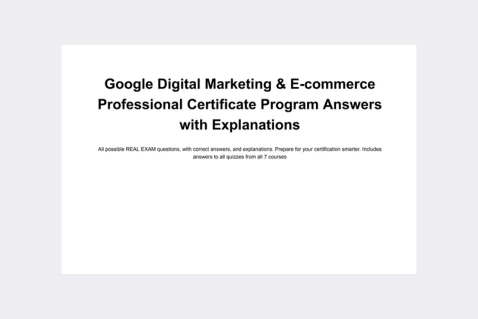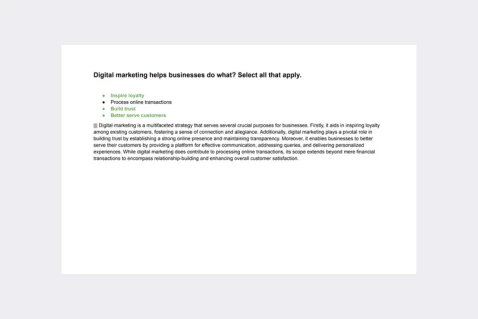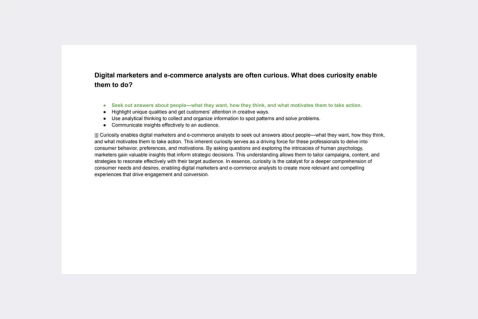Consider the following statement: Google rates the relevance of your ads and landing page to a query and how likely a user is to click your ad. What does this refer to?
Ad quality factors
Ad Rank factors
Ad position status
Keyword match types
Certification program: 👉 Google Digital Marketing & E-commerce Professional Certificate (Coursera)
Explanation: The statement “Google rates the relevance of your ads and landing page to a query and how likely a user is to click your ad” refers to Ad Rank factors. Ad Rank is a crucial metric in online advertising, particularly in Google Ads, determining the position and visibility of an ad in search engine results. Google considers various factors when calculating Ad Rank, and the relevance of the ad to the user’s query, along with the quality of the landing page and the expected click-through rate, are key components. Advertisers aiming for a higher Ad Rank should focus on creating relevant and compelling ads, ensuring alignment with user intent, and optimizing landing pages for a positive user experience to enhance the likelihood of clicks.
Passing exams is not a workout. Multiple attempts won’t make you stronger.



- All possible certificate program questions
- Real certification exam questions
- Detailed answer explanations.
- Over 1700 questions, 7 courses, 30 quizzes
- Free lifetime updates.
Understanding Google’s Ad Relevance and Click-Through Likelihood
In the realm of digital advertising, achieving success with Google Ads requires more than just bidding on keywords and setting a budget. Google’s ad ranking algorithm takes into account various factors to determine the relevance of your ads and landing pages to a user’s query, as well as the likelihood of a user clicking on your ad. But what exactly does this refer to, and how can advertisers optimize their campaigns to improve ad relevance and click-through rates (CTRs)? Let’s delve into this topic and explore some practical insights.
Deciphering Ad Relevance and Click-Through Likelihood
When a user enters a search query into Google, the search engine’s algorithm evaluates numerous signals to determine which ads to display and in what order. Two critical factors that Google considers are ad relevance and click-through likelihood:
-
Ad Relevance: This refers to how closely your ad copy and keywords match the user’s search query. Google assesses the relevance of your ad to the user’s intent and context, aiming to deliver ads that provide value and address the user’s needs or interests effectively.
-
Click-Through Likelihood: Google also evaluates the likelihood that a user will click on your ad based on factors such as ad position, ad format, ad extensions, and historical performance data. Ads with higher click-through rates are more likely to be displayed prominently and receive better placement in search results.
Practical Insights for Optimization
Here are some practical insights and strategies that advertisers can implement to optimize their Google Ads campaigns and improve ad relevance and click-through rates:
-
Keyword Optimization: Conduct thorough keyword research to identify relevant keywords and phrases that align with your target audience’s search queries and intent. Use these keywords strategically in your ad copy, headlines, and landing page content to enhance ad relevance and attract qualified traffic.
-
Compelling Ad Copy: Craft compelling and persuasive ad copy that entices users to click on your ad. Highlight unique selling points, offers, benefits, and calls-to-action (CTAs) to capture attention and drive engagement. Test different ad variations to identify what resonates best with your audience.
-
Landing Page Optimization: Ensure that your landing pages are optimized for relevance, usability, and conversion. Align the landing page content with the ad copy and keywords, provide clear and concise information, and streamline the conversion process with prominent CTAs and intuitive navigation.
-
Ad Extensions: Take advantage of ad extensions to enhance your ads with additional information and features, such as sitelinks, callouts, location information, and structured snippets. Ad extensions not only improve ad visibility and relevance but also provide users with more options to engage with your business.
-
Continuous Monitoring and Optimization: Regularly monitor the performance of your Google Ads campaigns and analyze key metrics such as CTRs, conversion rates, and quality scores. Identify underperforming ads or keywords and make data-driven adjustments to optimize ad relevance, targeting, and bidding strategies over time.
By focusing on ad relevance and click-through likelihood, advertisers can improve the effectiveness and efficiency of their Google Ads campaigns, drive higher-quality traffic to their websites, and ultimately achieve better ROI and business results.
In conclusion, Google’s assessment of ad relevance and click-through likelihood plays a crucial role in determining the success of your advertising efforts. By optimizing your ads for relevance, crafting compelling ad copy, optimizing landing pages, leveraging ad extensions, and continuously monitoring performance, you can enhance ad performance, attract more clicks, and drive meaningful outcomes for your business.
Discover our best-value guides
- Special Bundle Offer Google_Ads_Roll
- Special Bundle Offer HubSpot_Exams_Roll
- Special Offer Unchained_Guru_Roll
- Special Bundle Offer Amazon_Roll
- Special Bundle Offer Google_Analytics_Roll
- Special Bundle Offer Google_SkillShop_Roll
- Special Bundle Offer Marketing_Platforms_Roll
- Special Bundle Offer Microsoft_Advertising_Roll
- Special Bundle Offer YouTube_Roll
- Special Bundle Offer Google_Android_Roll
- Ultimate PMP certification preperation guide
- Google Cloud Professional Architect Certification Exam Answers - Ultimate Guide
- Special Bundle Offer SEMrush_Roll